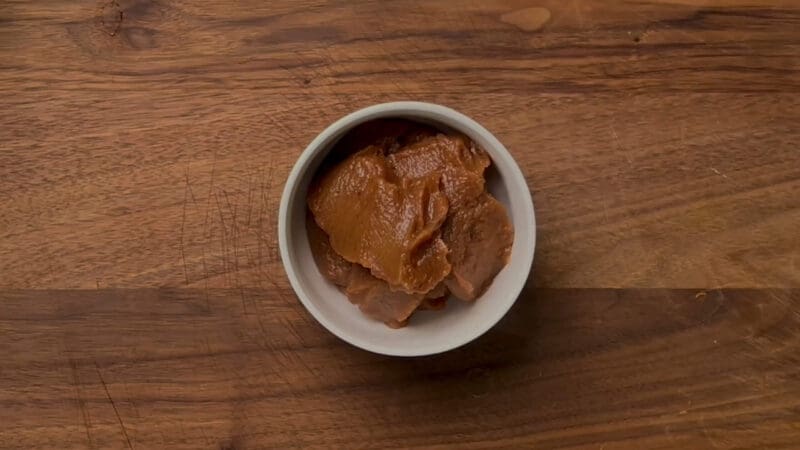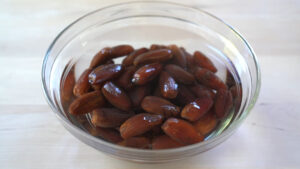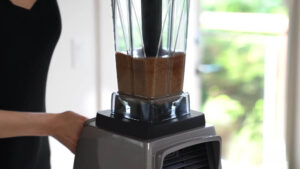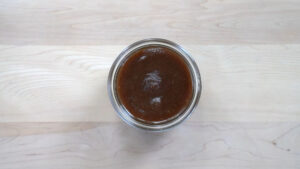Cutting back on added sugars can feel like a challenge. Even natural sweeteners like honey and maple syrup contain a lot of sugar. If you want to try something different, date paste might work for you.
Dates have a unique sweetness and texture. Unlike sugar or other syrups, dates come with fiber, which slows down sugar absorption in the body. It is a more nutrient-rich option compared to other sweeteners. Dates also provide essential minerals like potassium and magnesium, making them more than just a sugar replacement.
When made into paste, dates work well for those who want to bake or sweeten foods in a way that keeps the sweetness balanced and even. Chopped dates do not always mix well in recipes, but paste offers a smoother texture.
Let’s see how it’s made.

Homemade Date Paste
Equipment
- 1 Bowl for Soaking
- 1 Blender or food processor
- 1 Airtight container for storage
Ingredients
- 1 Cup Pitted Medjool Dates
- ½ Cup Warm Water For Soaking
Instructions
- Soak the DatesPlace 1 cup of pitted dates in a bowl and cover them with ½ cup of warm water. Let the dates soak for at least 3-4 hours. For a smoother paste, soak them overnight.
- Drain and BlendAfter soaking, drain the dates but reserve the soaking water. Place the soaked dates in a blender or food processor. Add a small amount of the soaking water (start with 1-2 tablespoons) and blend. Gradually add more water until the paste reaches your desired smooth consistency.
- StoreTransfer the paste into an airtight container and refrigerate. The date paste will keep for up to two weeks.
Video
Notes
- Texture Adjustments: If you want a thinner paste for drizzling, add a bit more soaking water. For a thicker paste, reduce the water.
- Enhancing Flavor: You can add a dash of vanilla extract, cinnamon, or a pinch of salt to deepen the flavor, depending on your use.
- Substitution Guide: In recipes calling for sugar, you can typically substitute 1 tablespoon of date paste for 1 teaspoon of sugar. This works well in baked goods like muffins or cookies, but you may need to experiment with liquid ratios.
Nutrition
Also, check out the recipe for homemade hummus.
How to Use Date Paste in Recipes?
Date paste can replace sugar in many recipes. For example, use it in muffins, cookies, or oatmeal. If a recipe calls for sugar, replace 1 teaspoon of sugar with 1 tablespoon of date paste. This substitution works in many cases, but you may need to experiment based on the recipe.
Nutritional Insights
| Sweetener | Calories per Tbsp | Sugar (g) | Fiber (g) | Potassium (mg) | Magnesium (mg) | Calcium (mg) | Iron (mg) |
|---|---|---|---|---|---|---|---|
| Date Paste | 25 | 6 | 0.5 | 195 | 15 | 16 | 0.2 |
| Table Sugar | 16 | 4 | 0 | 0 | 0 | 0 | 0 |
Health Benefits
- Rich in Fiber: Dates contain dietary fiber, which helps with digestion and keeps you feeling full.
- Packed with Nutrients: Dates are loaded with potassium, magnesium, and small amounts of iron.
- Low on the Glycemic Index: The natural sugars in dates have a lower impact on blood sugar levels compared to refined sugar.
Health.com highlights that dates are rich in antioxidants, which help reduce oxidative stress and support heart health.
Recipe Ideas
Once you have made your paste, try it in different recipes:
- Oatmeal Sweetener: Stir in a spoonful to sweeten your oatmeal naturally.
- Muffins: Add date paste to muffin batter as a sugar replacement.
- Smoothies: Blend it into smoothies for a rich, caramel-like sweetness.
- Energy Bites: Combine with oats, nuts, and seeds for quick, healthy snacks.
Final Thoughts
If you want to avoid added sugars, date paste offers a simple and healthy solution. Its rich flavor and natural sweetness make it a good fit for a range of recipes. Keep some on hand to replace sugar and give your dishes a nutritional boost.




